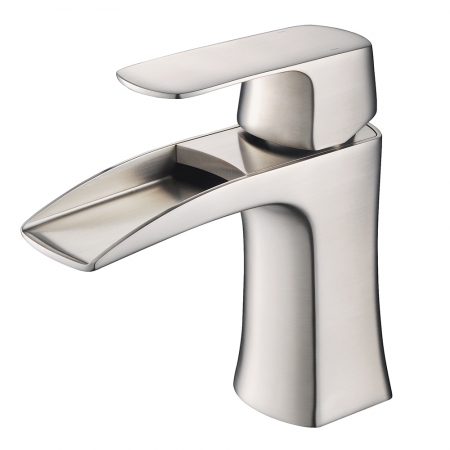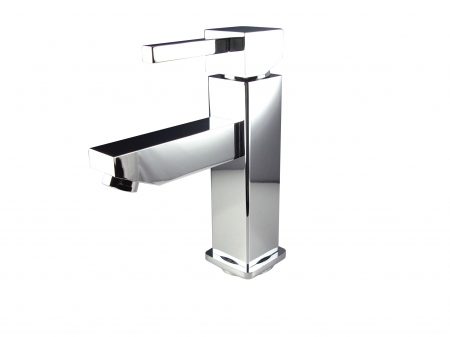Faucet selection doesn’t sound like something that will be that involved – and then you walk into your local big-box home improvement store and see an entire aisle dedicated to faucets and fixtures for sinks, along with another one strictly for bathroom sinks and tubs – it quickly gets overwhelming. Fortunately, if you take the time to do a little research, it won’t be difficult to select the perfect faucet for your tub and your bathroom vanity sink(s).
To help with that research, we’ve compiled everything you need to know about choosing the best faucet for your bathroom vanity or bathtub below.
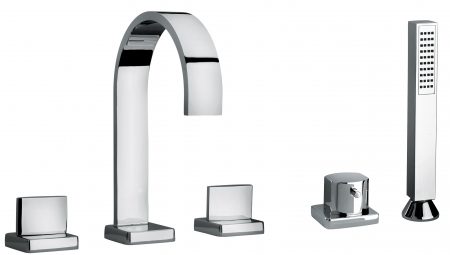
Dual Lever Roman Tub Faucet with Hand Shower
What’s the Difference Between Sink Faucets and Tub Faucets?
People must first understand the difference between sink and tub faucets. They are different, partly due to their design and partly due to the amount of water that flows through them (flow rate). Obviously, tubs will require faucets with a higher flow rate to fill the entire tub, whereas a sink could have a simple faucet with a low flow rate.
These faucets work similarly – the handle(s) will turn the water on and operate the hot and cold options, while the tap will be responsible for dispensing the water from the main plumbing pipes. However, they are installed differently and there are several different types to choose from.
Related: 10 Questions About Bathroom Sink Faucets
Brushed Nickel Single Hole Bathroom Faucet
Different Installation Types
Both sink and tub faucets come in two main installation styles: single-hole or three-hole. You do have the option of which to go with, but you also have to consider what’s existing in terms of plumbing and what the tub or sink requires. For example, single-hole sinks only have one hole drilled for a single unit, including the faucet, handle, and hot and cold adjustments. Three-hole sinks and tubs will require you to choose a fixture with a faucet and a separate hot and cold tap.
When choosing the bathtub or sink itself, you might want to consider the faucet installation options. The stone and ceramic materials used in bathrooms usually come pre-drilled for the faucet installation, so you’ll need to know what you are looking at in terms of being able to choose faucets for your space. Once you know that, you can move on to the rest of the features.
Related: 8 Trending Vessel Sink Bathroom Vanities
Is There a Difference Between a Tub Filler and a Faucet?
In the bathroom, the tub filler is becoming a popular choice. Unlike a traditional faucet, it connects to a 1/2-inch supply (instead of the traditional 3/8-inch) so that water can flow in faster and fill the tub more efficiently. Slow-flow faucets are great for water conservation but can cost more when filling a tub because they have to run so long to get it full.
If you choose a deep soaking tub, you may want to install a tub filler in addition to your standard faucets. You can learn more about tub fillers with the help of the experts over at Build.com and their guide to choosing and using tub fillers.
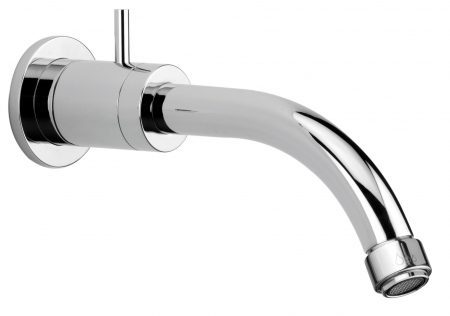
Single Hole Wall Mount Bathroom Faucet
How Do I Know What Faucet Will Fit My Bathroom Sink or Tub?
As mentioned in the installation section above, most sinks and tubs have a pre-drilled place for installing the faucet and/or taps. Some will have three holes. Others will be single-hole faucet installations. In either case, which you are working with will be pretty clear. If you haven’t picked a sink or tub yet, you can take advantage of a wider range of faucet options and then choose your sink tub based on the model that you choose.
If you work with an expert, they will also be able to help you determine which faucets can fit your tub or sink. Usually, as long as they are made for the right size holes and the appropriate use (sink versus bathtub faucets, etc.), they should fit fine. There aren’t a lot of size differences in terms of faucets when it comes to functional and installation factors. Even when they are larger or smaller, that’s just the fixture itself, and purely for design purposes in most instances.
Related: Garden Tubs Vs. Luxury Showers

Three Hole Waterfall Bathroom Vanity Faucet
Key Features to Look for In a Faucet
To help you better choose the faucets for your bathroom upgrade (or when you get around to renovating the kitchen) here are some features that need to be on your list.
Flow Rate
The flow rate of the faucet is a primary concern. In addition to how fast it will fill the sink or tub, the flow rate can tell you how much water it will use. Many models are made today with low-flow options so that they reduce water waste and help increase efficiency. You will want to pay special attention to the flow rate when choosing a tub faucet, or upgrading to a tub filler for more efficient filling.
You don’t have to memorize flow rate numbers or get a specific rating—just understand how flow rates work and choose fixtures that will ensure that you get the water pressure that you deserve.

Dual Lever Roman Tub Faucet with Finish Option
Eco-Friendly Features
In addition to the flow rate, faucets and taps today have several different eco-friendly features. Some use a single tap to reduce the energy used to switch between cold and hot water. Modern faucets often include built-in energy-saving flow guards so that you can get a smooth flow and save water. You can also choose faucets that simply have a lower flow rate so that they don’t waste water.
Related: 12 Questions And Answers About Vessel Sinks
Installation Type
The installation type plays a big role in the faucet that you choose. Sinks and tubs usually come pre-drilled for a specific type of faucet. Some have three holes for separate taps and a faucet, while some have a single hole for a singular faucet/tap unit. You’ll also want to consider the spout reach and height when installed to ensure that it meets your needs.
If you are buying a faucet for the tub that also has a shower, you’ll want to make sure that it also has the appropriate shower function. This could be a lever on the faucet, a knob or handle of its own, or another type of installation. If you don’t choose a shower-friendly faucet, you’ll be stuck taking baths until you fix the situation. Finally, if you have any concerns about installation, talk to your contractor or designer to make sure that you get the right faucet.
Chrome Single Hole Bathroom Faucet
Finish
Mismatched finishes just look bad in a bathroom. If you’re choosing a faucet for a sink that is on a vanity with chrome hardware, you’ll want a chrome faucet. If your hardware is brushed nickel, choose a brushed nickel faucet to finish the look. This is the first rule of finishes.
The second rule is to consider durability. Chrome is the most durable and easiest finish to maintain. It’s been a favorite for public bathrooms and commercial spaces because of this and is ideal for spaces that get a lot of use. Nickel is durable enough, but can be prone to water spots and fingerprints. Bronze can chip or scratch easier because the material is an epoxy surface coating, not metal.

Single Hole Vessel Sink Faucet with Finish Option
Tips for Choosing the Best Faucets for Any Fixture
In addition to looking for the features above, there are some other things that you can do to ensure that you get the right faucet for your tub or sink.
Single-handle faucets are more convenient. They make it easier to adjust temperatures and there is one less part of the fixture to keep clean. However, they may not offer all the design options that you can find in three-hole faucets, so you’ll have to consider the pros and cons of each.
Pull-down sprayers are far more effective and less problematic than side-mounted sprayers that have their own connection and hose. In the bathroom, people rarely choose the sprayer option for sinks, but it’s a good note just in case.
Choose a faucet that includes ceramic valves. They cost about the same, but they will last a lot longer than other valves and save you from those pesky, unwanted drips.
Choose your faucet(s) first. Sometimes, when you’re struggling to pull together a design, you can find one piece of inspiration and go from there. Choose your faucet as that focal point and see what kind of space you can create around it.
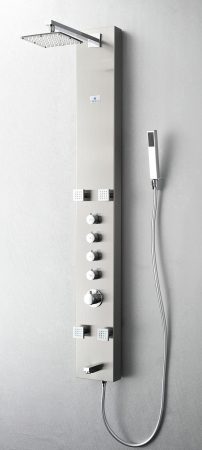
Stainless Steel Thermostatic Shower Massage Panel
The Bottom Line
As you can see, there’s a lot to consider when it comes to buying the right faucets for your bathroom space. Fortunately, there are also a lot of options out there that will suit just about every need and taste. Remember to consider the use of the faucet and then factor in the buying considerations because what you want in a sink faucet is different than what you might want in a tub faucet, and vice versa. Many models are available in matching sets, too, so that you can get the same hardware for your sink, tub, and every other part of your bathroom to complete the look.
Related: Remodeling A Bathroom On A Budget: Where Should You Focus Your Money?
Resources
https://www.signaturehardware.com/ideas-buying-guide-tub-faucet.html
https://www.hgtv.com/design/remodel/bathroom-remodel/how-to-pick-bathroom-faucets
https://www.bhg.com/home-improvement/advice/maintenance-repair/how-to-fix-a-leaky-faucet/
https://www.lowes.com/n/buying-guide/bathroom-faucet-buying-guide1
https://www.moen.com/inspiration/bathroom/how-to-choose-the-right-bathroom-faucet
https://www.houzz.com/magazine/your-guide-to-buying-a-bathroom-faucet-stsetivw-vs~132197497
https://www.build.com/how-to-choose-a-bathroom-faucet/a24
https://www.qualitybath.com/discover/post/18226/guide-water-flow-rates
https://www.build.com/choose-the-right-tub-faucet/a23303
https://www.moen.com/inspiration/bathroom/sink-configuration

